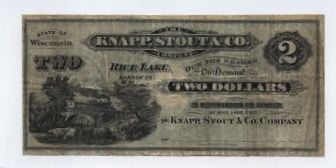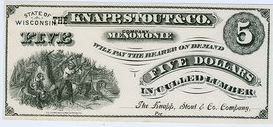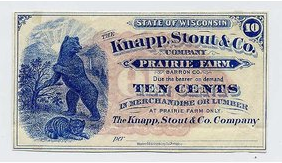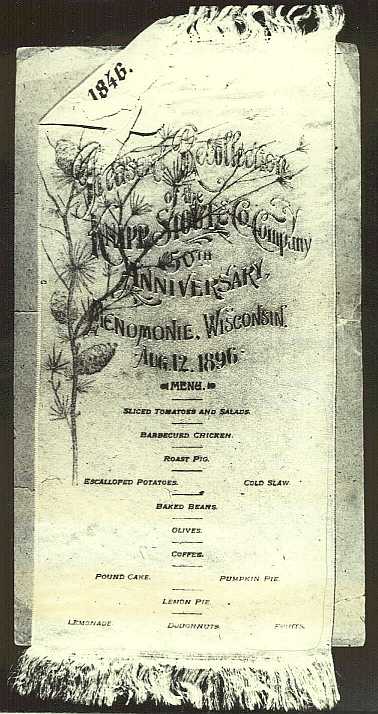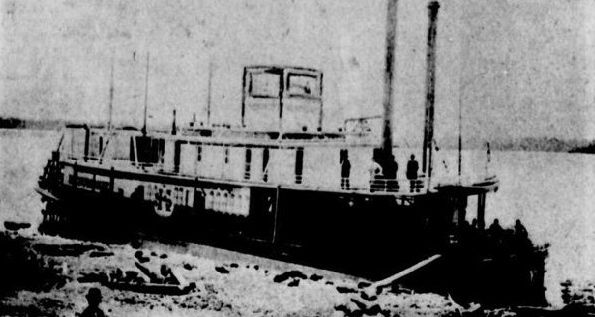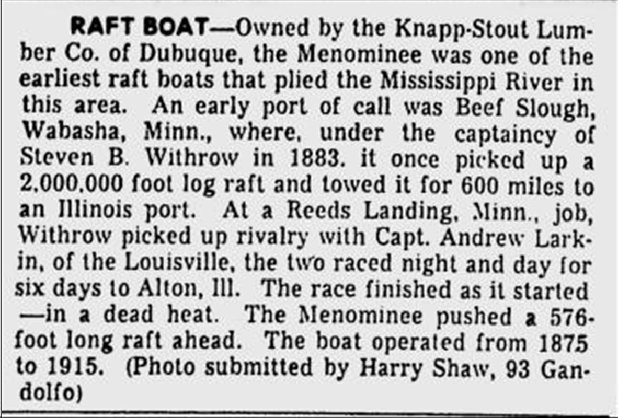Encyclopedia Dubuque
"Encyclopedia Dubuque is the online authority for all things Dubuque, written by the people who know the city best.”
Marshall Cohen—researcher and producer, CNN
Affiliated with the Local History Network of the State Historical Society of Iowa, and the Iowa Museum Association.
KNAPP, STOUT AND COMPANY: Difference between revisions
No edit summary |
No edit summary |
||
| Line 2: | Line 2: | ||
[[Image:kscurrency21.png|left|thumb|350px|Note the form of payment.]] | [[Image:kscurrency21.png|left|thumb|350px|Note the form of payment.]] | ||
[[Image:kstoken11.png|left|thumb|250px|Good for lumber or merchandise]] | [[Image:kstoken11.png|left|thumb|250px|Good for lumber or merchandise]] | ||
KNAPP, STOUT AND COMPANY. One of the largest lumber companies in Dubuque. A successor in 1854 to the [[KNAPP-TAINTER LUMBER COMPANY]], the firm experienced a rapid expansion between 1866 and 1869 with three mills opened in Wisconsin. The involvement of [[STOUT, Henry L.|Henry L. STOUT]] led to the renaming of Knapp-Tainter to Knapp-Stout by 1854. | KNAPP, STOUT AND COMPANY. One of the largest lumber companies in Dubuque. A successor in 1854 to the [[KNAPP-TAINTER LUMBER COMPANY]], the firm experienced a rapid expansion between 1866 and 1869 with three mills opened in Wisconsin. The involvement of [[STOUT, Henry L.|Henry L. STOUT]] led to the renaming of Knapp-Tainter to Knapp-Stout by 1854. (1) | ||
The mill at Menomonie eventually became the company's largest warehouse. Employing seven hundred workers in 1866, the Menomonie mill became the company headquarters in 1886 and employed two thousand workers by 1898. ( | The mill at Menomonie eventually became the company's largest warehouse. Employing seven hundred workers in 1866, the Menomonie mill became the company headquarters in 1886 and employed two thousand workers by 1898. (2) In Dubuque, lumberyards belonging to the company stretched over twenty acres and employed an estimated one hundred fifty men. | ||
In 1869 the company made its first expansion into shipping by purchasing the steamboat" Anna Girdon" to transport cut timber. This allowed the company to make considerable savings and survive tough competition in the [[LUMBER INDUSTRY]]. Between 1871 and 1881 the company's shipping fleet expanded to eight ships. | In 1869 the company made its first expansion into shipping by purchasing the steamboat" Anna Girdon" to transport cut timber. This allowed the company to make considerable savings and survive tough competition in the [[LUMBER INDUSTRY]]. (3) Between 1871 and 1881 the company's shipping fleet expanded to eight ships. (4) | ||
By 1881 the company had branch offices | By 1881 the company had branch offices in Dubuque, Downsville, Waubeck, Reed's Landing and St. Louis. There were small mills at Rice Lake and Prairie Farm. (5) In 1882 a merger with the Red Cedar Improvement and Log Driving Company increased the capital stock of the company. (6) On January 6, 1890 Knapp-Stout sold its seventh street mill in Dubuque to two of its former salesmen, C. J. Lesure and J. J. Van Villet. (7) This mill was developed into the LESURE LUMBER COMPANY. (2) | ||
[[Image:menu.jpg|left|thumb|350px|The menu at the 50th anniversary of the company. Photo courtesy: www.uwstout.edu/lib/archives/photoarch.cfm ]]A disastrous fire in June 1894, led to the loss of approximately fourteen million feet of lumber. The liquidation of the company timberlands in Wisconsin led to the November 1900, announcement that the Dubuque branch would be closed. The company intended on centralizing itself in St. Louis. This site, however, was sold in 1903 for one million dollars.( | [[Image:menu.jpg|left|thumb|350px|The menu at the 50th anniversary of the company. Photo courtesy: www.uwstout.edu/lib/archives/photoarch.cfm ]]A disastrous fire in June 1894, led to the loss of approximately fourteen million feet of lumber. The liquidation of the company timberlands in Wisconsin led to the November 1900, announcement that the Dubuque branch would be closed. (8) The company intended on centralizing itself in St. Louis. This site, however, was sold in 1903 for one million dollars.(9) | ||
In 1901, the company (using the same name) was incorporated by C. W. Chapman and [[STOUT, Frank D.|Frank D. STOUT]] with a capitalization of $100,000. ( | In 1901, the company (using the same name) was incorporated by C. W. Chapman and [[STOUT, Frank D.|Frank D. STOUT]] with a capitalization of $100,000. (10) In 1908 the company was sold to [[SPAHN AND ROSE LUMBER COMPANY]]. (11) | ||
The 1861 | The 1861 through 1890-91 ''Dubuque City Directory'' stated that this business was to be found at the northeast corner of 8th and Washington. | ||
[[Image:rboat.jpg|left|thumb|350px|]] | [[Image:rboat.jpg|left|thumb|350px|]] | ||
| Line 28: | Line 28: | ||
Source: | Source: | ||
1. | 1. Kerker, Renae. "The Sage of the Sawdust: The Life of Henry L. Stout," Unpublished thesis, December 1, 1979, p. 2 | ||
2. | 2. Hudson, David; Bergman, Marvin; Horton, Loren. ''The Biographical Dictionary of Iowa''. Iowa City: The University of Iowa Press, 2008. p. 497 | ||
3. Ibid. | 3. Kerker, p. 3 | ||
4. Hudson, p. 496 | |||
5. Kerker, p. 3 | |||
6. Kerker, p. 4 | |||
7. Ibid. | |||
8. Kerker, p. 5 | |||
9. Ibid. | |||
10. Ibid. | |||
1. Ibid. | |||
DCHS: The Knapp, Stout and Co. Company. Online | DCHS: The Knapp, Stout and Co. Company. Online | ||
Revision as of 17:39, 13 May 2014
KNAPP, STOUT AND COMPANY. One of the largest lumber companies in Dubuque. A successor in 1854 to the KNAPP-TAINTER LUMBER COMPANY, the firm experienced a rapid expansion between 1866 and 1869 with three mills opened in Wisconsin. The involvement of Henry L. STOUT led to the renaming of Knapp-Tainter to Knapp-Stout by 1854. (1)
The mill at Menomonie eventually became the company's largest warehouse. Employing seven hundred workers in 1866, the Menomonie mill became the company headquarters in 1886 and employed two thousand workers by 1898. (2) In Dubuque, lumberyards belonging to the company stretched over twenty acres and employed an estimated one hundred fifty men.
In 1869 the company made its first expansion into shipping by purchasing the steamboat" Anna Girdon" to transport cut timber. This allowed the company to make considerable savings and survive tough competition in the LUMBER INDUSTRY. (3) Between 1871 and 1881 the company's shipping fleet expanded to eight ships. (4)
By 1881 the company had branch offices in Dubuque, Downsville, Waubeck, Reed's Landing and St. Louis. There were small mills at Rice Lake and Prairie Farm. (5) In 1882 a merger with the Red Cedar Improvement and Log Driving Company increased the capital stock of the company. (6) On January 6, 1890 Knapp-Stout sold its seventh street mill in Dubuque to two of its former salesmen, C. J. Lesure and J. J. Van Villet. (7) This mill was developed into the LESURE LUMBER COMPANY. (2)
A disastrous fire in June 1894, led to the loss of approximately fourteen million feet of lumber. The liquidation of the company timberlands in Wisconsin led to the November 1900, announcement that the Dubuque branch would be closed. (8) The company intended on centralizing itself in St. Louis. This site, however, was sold in 1903 for one million dollars.(9)
In 1901, the company (using the same name) was incorporated by C. W. Chapman and Frank D. STOUT with a capitalization of $100,000. (10) In 1908 the company was sold to SPAHN AND ROSE LUMBER COMPANY. (11)
The 1861 through 1890-91 Dubuque City Directory stated that this business was to be found at the northeast corner of 8th and Washington.
---
Source:
1. Kerker, Renae. "The Sage of the Sawdust: The Life of Henry L. Stout," Unpublished thesis, December 1, 1979, p. 2
2. Hudson, David; Bergman, Marvin; Horton, Loren. The Biographical Dictionary of Iowa. Iowa City: The University of Iowa Press, 2008. p. 497
3. Kerker, p. 3
4. Hudson, p. 496
5. Kerker, p. 3
6. Kerker, p. 4
7. Ibid.
8. Kerker, p. 5
9. Ibid.
10. Ibid.
1. Ibid.
DCHS: The Knapp, Stout and Co. Company. Online
http://www.discover-net.net/~dchs/history/exkscc.html
Holand, H. R. "The Knapp-Stout & Co. Lumber Company." The Wisconsin Magazine of History, Vol. 3, No. 4, Jun., 1920. Online: http://www.jstor.org/stable/4630265
Knapp-Stout Company Founders. Online: http://www.rootsweb.ancestry.com/~widunn/knapp-stout-founders.htm
Knapp-Stout & Co. Company Photo Archive. Online: http://www.uwstout.edu/lib/archives/photoarch.cfm
KNAPP STOUT & CO MENOMONIE WI - $5 | CoinWorld. Online: http://beta.coinworld.com/dealers/denlys/knapp-stout-co-menomonie-wi-5/


